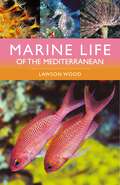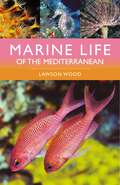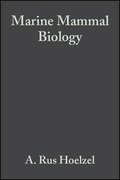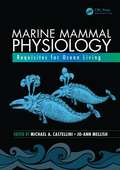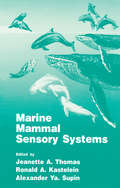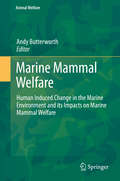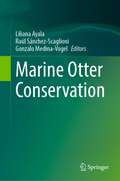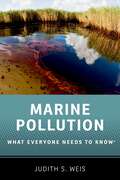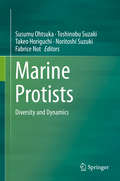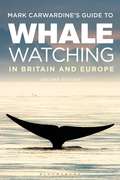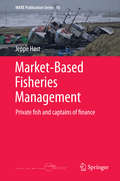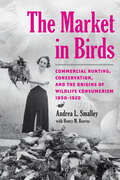- Table View
- List View
Marine Life of the Mediterranean
by Lawson WoodA new and updated edition of this popular title covering the fishes, invertebrates and other marine life of the Mediterranean Sea.Almost entirely enclosed by land, the Mediterranean Sea is surrounded by many popular wildlife destinations, including Spain, France, Italy, Malta, Gibraltar, Greece and Turkey. From sharks and turtles to algae and sponges, Marine Life of the Mediterranean reveals the fascinating wealth of sea life found in this diverse region. Featuring more than 290 species of fish, corals and other vertebrates and invertebrates, each species account includes key information on identification, habitats, diet and behaviour. Recommendations on where to go scuba diving, as well as important information on dangerous marine life, conservation zones and marine protected areas are also included. This compact and easy-to-follow guidebook – illustrated with colour photographs taken in a number of unique and exotic locations – is an essential companion for divers, snorkellers and underwater photographers visiting the area.
Marine Life of the Mediterranean
by Lawson WoodA new and updated edition of this popular title covering the fishes, invertebrates and other marine life of the Mediterranean Sea.Almost entirely enclosed by land, the Mediterranean Sea is surrounded by many popular wildlife destinations, including Spain, France, Italy, Malta, Gibraltar, Greece and Turkey. From sharks and turtles to algae and sponges, Marine Life of the Mediterranean reveals the fascinating wealth of sea life found in this diverse region. Featuring more than 290 species of fish, corals and other vertebrates and invertebrates, each species account includes key information on identification, habitats, diet and behaviour. Recommendations on where to go scuba diving, as well as important information on dangerous marine life, conservation zones and marine protected areas are also included. This compact and easy-to-follow guidebook – illustrated with colour photographs taken in a number of unique and exotic locations – is an essential companion for divers, snorkellers and underwater photographers visiting the area.
Marine Mammal Biology: An Evolutionary Approach
by A. Rus HoelzelThis book provides a general introduction to the biology of marine mammals, and an overview of the adaptations that have permitted mammals to succeed in the marine environment. Each chapter, written by experts in their field, will provide an up-to-date review and present the major discoveries and innovations in the field. Important technical advances such as satellite telemetry and time-depth-recorders will be described in boxes.
Marine Mammal Physiology: Requisites for Ocean Living (Crc Marine Biology Ser.)
by Michael A. Castellini Jo-Ann MellishSuppose you were designing a marine mammal. What would you need to think about to allow it to live in the ocean? How would you keep it warm? What would you design to allow it to dive for very long periods to extreme depths? Where would it find water to drink? How would you minimize the cost of swimming, and how would it find its prey in the deep an
Marine Mammal Sensory Systems
by Ronald A. Kastelein Alexander Ya Supin Jeanette A. ThomasThis book is a collection of original research papers given at a symposium entitled "Sensory Systems and Behavior of Aquatic Mammals", hosted by the USSR Academy of Sciences. The meeting was held in Moscow from 16 to 25 October, 1991 and involved nearly 100 scientists from around the world. The major headings of the book correspond to the session topics at the symposium. This meeting was not the first dedicated to problems of sensory systems in aquatic mammals. Experts in this field met several times previously to discuss important problems of sensory functions in echolocating animals. symposia on biosonar systems were held in Frascati, Italy in 1966, then in Jersey, France in 1978, and in Helsingor, Denmark in 1986. Papers presented at these meetings were pUblished in books that advanced significantly the understanding of sensory systems (Busnel and Fish, 1980; Nachtigall and Moore, 1988). Initially, echolocating bats were the main subjects of consideration. However, studies on echolocating aquatic mammals, whales and dolphins, increased from one meeting to the next. Indeed, aquatic mammals are of exceptional interest for studying the adaptation of sensory functions for echolocation in specific aquatic environments. As a natural consequence of these developments, the 1989 symposium in Rome was devoted specifically to the sensory systems of cetaceans (Thomas and Kastelein, 1990). This symposium was held within the Fifth International Theriological Congress and was attended by many scientists.
Marine Mammal Welfare: Human Induced Change in the Marine Environment and its Impacts on Marine Mammal Welfare (Animal Welfare #17)
by Andy ButterworthMarine mammals attract human interest – sometimes this interest is benign or positive – whale watching, conservation programmes for whales, seals, otters, and efforts to clear beaches of marine debris are seen as proactive steps to support these animals. However, there are many forces operating to affect adversely the lives of whales, seals, manatees, otters and polar bears – and this book explores how the welfare of marine mammals has been affected and how they have adapted, moved, responded and sometimes suffered as a result of the changing marine and human world around them. Marine mammal welfare addresses the welfare effects of marine debris, of human traffic in the oceans, of noise, of hunting, of whale watching and tourism, and of some of the less obvious impacts on marine mammals – on their social structures, on their behaviours and migration, and also of the effects on captivity for animals kept in zoos and aquaria. There is much to think and talk about – how marine mammals respond in a world dramatically influenced by man, how are their social structures affected and how is their welfare impacted?
Marine Mammals: A Deep Dive into the World of Science
by Dennis Brennecke Katrin Knickmeier Iwona Pawliczka Ursula Siebert Magnus WahlbergThis highly-readable Open Access textbook provides basic background information about marine mammals and anthropogenic impacts on them. The book includes inspiring exercises for education school programs in natural sciences. The book also provides advice on career paths using case studies of marine scientists and veterinarians describing their journeys from student to profession. By sharing real-life career paths, readers find answers to questions such as “What needs to be considered when choosing a career in science?” and “What kind of tasks do scientists undertake on a daily basis?” Marine mammals are amongst some of the most celebrated creatures on Earth, with their high intelligence, social and communicating skills, and capacity for deep diving. Alongside general information about marine mammals, the book aims at generating awareness of the impact of litter and noise pollution on the marine environment using marine mammals as an example. Huge numbers of marine animals, including marine mammals, die every year from entanglement in fishing gear, by ingestion of litter or because of chemical pollution. In the last decade many technological and scientific tools have been developed to aid research, for instance miniaturised sound recorders which can be attached to cetaceans and seals and record noise levels around them, their vocal production as well as their diving behaviour. This Open Access textbook can be used by undergraduate students interested in the fundamentals of marine mammal biology and medicine, and in pursuing the profession of a marine scientist.
Marine Mammals: Adaptations for an Aquatic Life
by Randall W. DavisThis comprehensive book provides new insights into the morphological, metabolic, thermoregulatory, locomotory, diving, sensory, feeding, and sleep adaptations of Cetacea (whales and dolphins), Pinnipedia (seals, sea lions and walrus), Sirenia (manatees and dugongs) and sea otters for an aquatic life. Each chapter reviews the discoveries from previous studies and integrates recent research using new techniques and technology. Readers will gain an understanding of the remarkable adaptations that enable marine mammals to spend all or most of their lives at sea, often while hunting prey at depth.
Marine Mammals: Biology and Conservation
by Peter G. H. Evans Juan Antonio RagaInterest in marine mammals has increased dramatically in the last few decades, as evidenced by the number of books, scientific papers, and conferences devoted to these animals. Nowadays, a conference on marine mammals can attract between one and two thousand scientists from around the world. This upsurge of interest has resulted in a body of knowledge which, in many cases, has identified major conservation problems facing particular species. At the same time, this knowledge and the associated activities of environmental organisations have served to introduce marine mammals to a receptive public, to the extent that they are now perceived by many as the living icons of biodiversity conservation. Much of the impetus for the current interest in marine mammal conservation comes from "Save the Whale" campaigns started in the 1960s by environmental groups around the world, in response to declining whale populations after over-exploitation by humans. This public pressure led to an international moratorium on whaling recommended in 1972 by the United Nations Conference on the Human Environment in Stockholm, Sweden, and eventually adopted by the International Whaling Commission ten years later. This moratorium largely holds sway to this day, and further protective measures have included the delimitation of extensive areas of the Indian Ocean (1979) and Southern Ocean (1994) as whale sanctuaries.
Marine Mammals: the Evolving Human Factor (Ethology and Behavioral Ecology of Marine Mammals)
by Giuseppe Notarbartolo di Sciara Bernd WürsigThe seventh volume in the series “Ethology and Behavioral Ecology of Marine Mammals” describes aspects of the often-complex relationship between humans and marine mammals. From a primeval condition of occasional predators, during the last century humans have become a major factor negatively affecting the status of most marine mammals through over-hunting, habitat encroachment and environmental degradation. This has led to the extirpation of many marine mammal populations and even to the extinction of species. However, in parallel to this destructive drive, since antiquity humanity has been influenced by a strong fascination for marine mammals, which contributes today to an increased human appreciation of the natural world admixed with widespread concern for its degrading condition. The special status occupied by marine mammals in human imagination and affection stands in stark contrast with the current predicament of many populations still threatened by the doings of Homo sapiens: a condition emblematic of the relationship of humanity with nature, and key to understanding where humanity is heading.
Marine Organisms as Model Systems in Biology and Medicine (Results and Problems in Cell Differentiation #65)
by Malgorzata Kloc Jacek Z. KubiakThis book highlights the potential advantages of using marine invertebrates like tunicates, echinoderms, sponges and cephalopods as models in both biological and medical research. Bioactive compounds found in marine organisms possess antibacterial, antifungal, anti-diabetic and anti-inflammatory properties, and can affect the immune and nervous systems. Despite substantial research on the medicinal attributes of various marine invertebrates, they are still very much underrepresented in scientific literature: the majority of cell, developmental and evolutionary scientific journals only publish research conducted on a few well-known model systems like Drosophila melanogaster or Xenopus laevis. Addressing that gap, this book introduces readers to new model organisms like starfish or nemertera. By showing their benefits with regard to regeneration, stem cell research and Evo-Devo, the authors provide a cross-sectional view encompassing various disciplines of biological research. As such, this book will not only appeal to scientists currently working on marine organisms, but will also inspire future generations to pursue research of their own.
Marine Otter Conservation
by Liliana Ayala Raúl Sánchez-Scaglioni Gonzalo Medina-VogelThis book offers a multidisciplinary approach to conservation issues related to the marine otter (Lontra felina). The main goal is the systematization of different research efforts on this species, to contribute with conservation policy design and implementation. The authors contribute their achievements in conservation, ecology, status in freshwater habitats, habitat fragmentation effects, interaction with human activities and recommendations for an effective conservation of the species. The book is directed first and foremost towards researchers and authorities and people involved in conservation tasks of otters.Despite in the last decades some studies and efforts on Lontra felina has carried in Peru and Chile, some information can be gathered to fill the gaps on marine otter conservation in Peru. That is the main goal of the book Conservation of Marine Otter. Moreover, the publication will be the first book published at international level on Lontra felina with the participation of several experimented researchers on this threatened and endemic species.
Marine Physiology Down East: The Story of the Mt. Desert Island Biological Laboratory (Perspectives in Physiology)
by David H. EvansThis volume offers a comprehensive history of the Mount Desert Island Biological Laboratory (MDIBL), one of the major marine laboratories in the United States and a leader in using marine organisms to study fundamental physiological concepts. Beginning with its founding as the Harpswell Laboratory of Tufts University in 1898, David H. Evans follows its evolution from a teaching facility to a research center for distinguished renal and epithelial physiologists. He also describes how it became the site of major advances in cytokinesis, regeneration, cardiac and vascular physiology, hepatic physiology, endocrinology and toxicology, as well as studies of the comparative physiology of marine organisms. Fundamental physiological concepts in the context of the discoveries made at the MDIBL are explained and the social and administrative history of this renowned facility is described.
Marine Pollution: What Everyone Needs to Know® (What Everyone Needs To Know®)
by Judith S. WeisMarine pollution occurs today in varied forms--chemical, industrial, and agricultural-and the sources of pollution are endless. In recent history, we've seen oil spills, untreated sewage, eutrophication, invasive species, heavy metals, acidification, radioactive substances, marine litter, and overfishing, among other significant problems. Though marine pollution has long been a topic of concern, it has very recently exploded in environmental, economic, and political debate circles; scientists and non-scientists alike continue to be shocked and dismayed at the sheer diversity of water pollutants and the many ways they can come to harm our environment and our bodies. In Marine Pollution: What Everyone Needs to Know, Judith Weis covers marine pollution from numerous angles, each fascinating in its own right. Beginning with its sources and history, she discusses common pollutants, why they are harmful, why they cause controversy, and how we can prevent them from destroying our aquatic ecosystems. Questions ask what actually happened with the Exxon Valdez, and why harmful algal blooms are a serious concern. Covering pollutants that are only now surfacing as major threats, such as pharmaceuticals, personal care products, and metal nanoparticles, she explains how these can begin in the water and progress up the food chain to emerge in human bodies. Looking at the effects of climate change and acidification on marine pollution levels, we learn how we can begin to reduce pollution at the local and global levels.
Marine Pollution: What Everyone Needs to Know® (What Everyone Needs To Know®)
by Judith S. WeisMarine pollution occurs today in varied forms--chemical, industrial, and agricultural-and the sources of pollution are endless. In recent history, we've seen oil spills, untreated sewage, eutrophication, invasive species, heavy metals, acidification, radioactive substances, marine litter, and overfishing, among other significant problems. Though marine pollution has long been a topic of concern, it has very recently exploded in environmental, economic, and political debate circles; scientists and non-scientists alike continue to be shocked and dismayed at the sheer diversity of water pollutants and the many ways they can come to harm our environment and our bodies. In Marine Pollution: What Everyone Needs to Know, Judith Weis covers marine pollution from numerous angles, each fascinating in its own right. Beginning with its sources and history, she discusses common pollutants, why they are harmful, why they cause controversy, and how we can prevent them from destroying our aquatic ecosystems. Questions ask what actually happened with the Exxon Valdez, and why harmful algal blooms are a serious concern. Covering pollutants that are only now surfacing as major threats, such as pharmaceuticals, personal care products, and metal nanoparticles, she explains how these can begin in the water and progress up the food chain to emerge in human bodies. Looking at the effects of climate change and acidification on marine pollution levels, we learn how we can begin to reduce pollution at the local and global levels.
Marine Protists: Diversity and Dynamics
by Susumu Ohtsuka Toshinobu Suzaki Takeo Horiguchi Noritoshi Suzuki Fabrice NotThis comprehensive book provides a unique overview of advances in the biology and ecology of marine protists. Nowadays marine protistology is a hot spot in science to disclose life phenomena using the latest techniques. Although many protistological textbooks deal with the cytology, genetics, ecology, and pathology of specific organisms, none keeps up with the quick pace of new discoveries on the diversity and dynamics of marine protists in general. The bookMarine Protists: Diversity and Dynamics gives an overview of current research on the phylogeny, cytology, genomics, biology, ecology, fisheries, applied sciences, geology and pathology of marine free-living and symbiotic protists. Poorly known but ecologically important protists such as labyrinthulids and apostome ciliates are also presented in detail. Special attention is paid to complex interactions between marine protists and other organisms including human beings. An understanding of the ecological roles of marine protists is essential for conservation of nature and human welfare. This book will be of great interest not only to scientists and students but also to a larger audience, to give a better understanding of protists’ diverse roles in marine ecosystems.
The Marine World: A Natural History of Ocean Life (Wild Nature Press)
by Frances DipperThe Marine World is a book for everyone with an interest in the ocean, from the marine biologist or student wanting expert knowledge of a particular group to the naturalist or diver exploring the seashore and beyond.With colour illustrations, line drawings, more than 1,500 colour photographs, and with clear accessible text, this book encompasses all those organisms that live in, on and around the ocean, bringing together in a single text everything from the minuscule to the immense. It includes sections on all but the most obscure marine groups, covering invertebrate phyla from sponges to sea squirts, as well as plants, fungi, bacteria, fish, reptiles, mammals and birds. It incorporates information on identification, distribution, structure, biology, ecology, classification and conservation of each group, addressing the questions of ‘what?’, ‘where?’ and ‘how?’.Today global warming, overfishing, ocean acidification and pollution are just a few of the ever increasing number of threats and challenges faced by ocean life. Without knowledge of the animals, plants and other organisms that live in the marine world, we cannot hope to support or implement successful conservation and management measures, nor truly appreciate the incredible wealth and variety of marine life.The Marine World is the product of a lifetime spent by Frances Dipper happily observing and studying marine organisms the world over. It has been brought to colourful life by a myriad of enthusiastic underwater photographers and by Marc Dando, the renowned natural history illustrator.
Mark Carwardine's Guide To Whale Watching In Britain And Europe: Second Edition
by Mark CarwardineA new and fully updated edition of this popular title, which is the definitive guide to watching whales, dolphins and porpoises in British and other European waters. A fascinating introduction to whales and whale watching is followed by a detailed field guide with spectacular illustrations, identification and behaviour tips, dive sequences and distribution maps for all the cetaceans of Europe. The final part of the book provides a comprehensive guide to Europe's major whale watching sites, covering 19 countries in all, from Scotland and Ireland to Spain and Norway. Imagine watching Minke Whales in the light of the midnight sun in Iceland; snorkelling with a wild Bottlenose Dolphin; or sharing a day with a group of Blue Whales against a spectacular backdrop of snow-capped mountains. These are just a few of the whale and dolphin watching experiences now available in different parts of Europe, which is rapidly becoming a hot-spot for this exhilarating activity.
Mark Carwardine's Guide To Whale Watching In Britain And Europe: Second Edition
by Mark CarwardineA new and fully updated edition of this popular title, which is the definitive guide to watching whales, dolphins and porpoises in British and other European waters. A fascinating introduction to whales and whale watching is followed by a detailed field guide with spectacular illustrations, identification and behaviour tips, dive sequences and distribution maps for all the cetaceans of Europe. The final part of the book provides a comprehensive guide to Europe's major whale watching sites, covering 19 countries in all, from Scotland and Ireland to Spain and Norway. Imagine watching Minke Whales in the light of the midnight sun in Iceland; snorkelling with a wild Bottlenose Dolphin; or sharing a day with a group of Blue Whales against a spectacular backdrop of snow-capped mountains. These are just a few of the whale and dolphin watching experiences now available in different parts of Europe, which is rapidly becoming a hot-spot for this exhilarating activity.
Mark Carwardine's Guide to Whale Watching in North America
by Mark CarwardineCommercial whale-watching began in 1955 in California, when a San Diego fisherman started taking people (for a dollar a time) to see Grey Whales migrating along the coast. Nowadays, 13 million people go whale-watching each year, in 119 different countries around the world. The undisputed hotspot – with more than half of all whale-watchers – is North America. Mark Carwardine's Guide to Whale-Watching in North America is the second in a series aimed at millions of whale addicts around the world. It includes some of the world's ultimate wildlife experiences: tickling friendly grey whales in Mexico's San Ignacio Lagoon, listening to a live concert of singing humpback whales in Hawaii, being surrounded by thousands of dolphins in Monterey Bay, kayaking with pods of Orca off Vancouver Island, snorkelling with Beluga in Hudson Bay, and many more. It covers all the main whale-watching locations in the United States, Canada and Mexico; rich with photography throughout, the book will also include sections on how to watch whales (including everything from identification to interpreting behaviour), and a field-guide section covering all the whales, dolphins and porpoises that can be seen in North America. Mark Carwardine once again brings us a definitive guide, this time for all who love whales in North America.
Mark Johnston: Phenomenon
by Nick TownsendA new, fully authorised biography of the most successful trainer in British horse racing history.In the stratified and often secretive world of racehorse training, Mark Johnston has always been different: forthright, combative, provocative, and candid – a man who delights in questioning convention. Over more than three decades, he has gone from being a vet from a thoroughly working-class Scottish background to, mathematically, the most successful trainer in the history of British horse racing.In this new, fully authorised biography, acclaimed author Nick Townsend provides a unique insight into the world of Mark Johnston and his phenomenally successful operation. With unparalleled access to Mark and those closest to him, Mark Johnston: Phenomenon will dig into his storied career, his strong and passionate views on the sport of horse racing, and how he's planning for the future in unprecedented times, offering a fascinating portrait of one of horse racing's most singular figures.
Market-Based Fisheries Management: Private fish and captains of finance (MARE Publication Series #16)
by Jeppe HøstThis book reveals how a privatization of fish resources has paved the way for a wide-reaching concentration and change in ownership. It is a thought-provoking contribution to the debate on the future of European fisheries and the possible solutions to overfishing in Europe. Readers will discover a timely, critical insight into the social, cultural and economic aspects and consequences of market-based fisheries management. The privatization of fish quotas in Denmark represents one of the most far-reaching and comprehensive privatization schemes of its kind and has been widely promoted as a market-based system with innovative social safeguards. This work critically examines this privatization of fish resources, combining quantitative and qualitative material to provide new understanding of fish quotas and their social value. Scholars with an interest in privatization and the socio-economic aspects of fisheries, and those working with NGOs, fishers and fisheries, and concerned with political conflicts will all value the research presented here.
The Market in Birds: Commercial Hunting, Conservation, and the Origins of Wildlife Consumerism, 1850–1920
by Andrea L. SmalleyA fascinating look at how a commercial market for birds in the late nineteenth century set the stage for conservation and its legislation.Between the end of the Civil War and the 1920s, the United States witnessed the creation, rapid expansion, and then disappearance of a commercial market for hunted wild animals. The bulk of commercial wildlife sales in the last part of the nineteenth century were of wildfowl, who were prized not only for their eggs and meat but also for their beautiful feathers. Wild birds were brought to cities in those years to be sold as food for customers' tables, decorations for ladies' hats, treasured pets, and specimens for collectors' cabinets. Though relatively short-lived, this market in birds was broadly influential, its rise and fall coinciding with the birth of the Progressive Era conservation movement. In The Market in Birds, historian Andrea L. Smalley and wildlife biologist Henry M. Reeves illuminate this crucial chapter in American environmental history. Touching on ecology, economics, law, and culture, the authors reveal how commercial hunting set the terms for wildlife conservation and the first federal wildlife legislation at the turn of the twentieth century. Smalley and Reeves delve into the ground-level interactions among market hunters, game dealers, consumers, sportsmen, conservationists, and the wild birds they all wanted. Ultimately, they argue, wildfowl commercialization represented a revolutionary shift in wildlife use, turning what had been a mostly limited, local, and seasonal trade into an interstate industrial-capitalist enterprise. In the process, it provoked a critical public debate over the value of wildlife in a modern consumer culture. By the turn of the twentieth century, the authors reveal, it was clear that wild bird populations were declining precipitously all over North America. The looming possibility of a future without birds sparked intense debate nationwide and eventually culminated in the 1918 Migratory Bird Treaty Act. Scholars, environmentalists, wildlife professionals, and anyone concerned about wildlife will find this new perspective on conservation history enlightening reading.
The Market in Birds: Commercial Hunting, Conservation, and the Origins of Wildlife Consumerism, 1850–1920
by Andrea L. SmalleyA fascinating look at how a commercial market for birds in the late nineteenth century set the stage for conservation and its legislation.Between the end of the Civil War and the 1920s, the United States witnessed the creation, rapid expansion, and then disappearance of a commercial market for hunted wild animals. The bulk of commercial wildlife sales in the last part of the nineteenth century were of wildfowl, who were prized not only for their eggs and meat but also for their beautiful feathers. Wild birds were brought to cities in those years to be sold as food for customers' tables, decorations for ladies' hats, treasured pets, and specimens for collectors' cabinets. Though relatively short-lived, this market in birds was broadly influential, its rise and fall coinciding with the birth of the Progressive Era conservation movement. In The Market in Birds, historian Andrea L. Smalley and wildlife biologist Henry M. Reeves illuminate this crucial chapter in American environmental history. Touching on ecology, economics, law, and culture, the authors reveal how commercial hunting set the terms for wildlife conservation and the first federal wildlife legislation at the turn of the twentieth century. Smalley and Reeves delve into the ground-level interactions among market hunters, game dealers, consumers, sportsmen, conservationists, and the wild birds they all wanted. Ultimately, they argue, wildfowl commercialization represented a revolutionary shift in wildlife use, turning what had been a mostly limited, local, and seasonal trade into an interstate industrial-capitalist enterprise. In the process, it provoked a critical public debate over the value of wildlife in a modern consumer culture. By the turn of the twentieth century, the authors reveal, it was clear that wild bird populations were declining precipitously all over North America. The looming possibility of a future without birds sparked intense debate nationwide and eventually culminated in the 1918 Migratory Bird Treaty Act. Scholars, environmentalists, wildlife professionals, and anyone concerned about wildlife will find this new perspective on conservation history enlightening reading.
Marley: A Dog Like No Other
by John GroganA heart-warming story about the World’s Worst Dog, adapted from John Grogan’s phenomenally bestselling memoir, Marley and Me.
